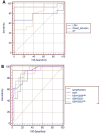COVID-19 Infection in Patients with Comorbidities: Clinical and Immunological Insight
- PMID: 35698744
- PMCID: PMC9201308
- DOI: 10.1177/10760296221107889
COVID-19 Infection in Patients with Comorbidities: Clinical and Immunological Insight
Abstract
Aim: Our study's objectives were to study the clinical and laboratory characteristics that may serve as biomarkers for predicting disease severity, IL-10 levels, and frequencies of different T cell subsets in comorbid COVID-19 patients.
Methods: Sixty-two hospitalized COVID-19 patients with comorbidities were assessed clinically and radiologically. Blood samples were collected to assess the T lymphocyte subsets by flow cytometry and IL-10 levels by ELISA.
Results: The most common comorbidities observed in COVID-19 patients were diabetes mellitus (DM), hypertension, and malignancies. Common symptoms and signs included fever, cough, dyspnea, fatigue, myalgia, and sore throat. CRP, ferritin, D dimer, LDH, urea, creatinine, and direct bilirubin were significantly increased in patients than controls. Lymphocyte count and CD4+ and CD8+ T-cells were significantly decreased in comorbid COVID-19 patients, and CD25 and CD45RA expression were increased. CD4+ and CD8+ regulatory T cells (Tregs) and IL-10 levels were significantly decreased in patients.
Conclusions: Many parameters were found to be predictive of severity in the comorbid patients in our study. Significant reductions in the levels and activation of CD4+ and CD8+ T-cells were found. In addition, CD4+ and CD8+ Tregs were significant decreased in patients, probably pointing to a prominent role of CD8+ Tregs in dampening CD4+ T-cell activation.
Keywords: COVID-19; SARS-coV-2; comorbidities; t cells; tregs.
Conflict of interest statement
Figures





Similar articles
-
Risk Factors for Mortality of COVID-19 Patient Based on Clinical Course: A Single Center Retrospective Case-Control Study.Front Immunol. 2021 Feb 16;12:581469. doi: 10.3389/fimmu.2021.581469. eCollection 2021. Front Immunol. 2021. PMID: 33664741 Free PMC article.
-
Dynamics of cytokines and lymphocyte subsets associated with the poor prognosis of severe COVID-19.Eur Rev Med Pharmacol Sci. 2020 Dec;24(23):12536-12544. doi: 10.26355/eurrev_202012_24051. Eur Rev Med Pharmacol Sci. 2020. PMID: 33336774
-
Clinical characteristics and predictive value of lower CD4+T cell level in patients with moderate and severe COVID-19: a multicenter retrospective study.BMC Infect Dis. 2021 Jan 12;21(1):57. doi: 10.1186/s12879-020-05741-w. BMC Infect Dis. 2021. PMID: 33435865 Free PMC article.
-
Lymphocyte Subset Counts in COVID-19 Patients: A Meta-Analysis.Cytometry A. 2020 Aug;97(8):772-776. doi: 10.1002/cyto.a.24172. Epub 2020 Jul 18. Cytometry A. 2020. PMID: 32542842 Free PMC article. Review.
-
Deciphering the COVID-19 cytokine storm: Systematic review and meta-analysis.Eur J Clin Invest. 2021 Jan;51(1):e13429. doi: 10.1111/eci.13429. Epub 2020 Nov 2. Eur J Clin Invest. 2021. PMID: 33058143 Free PMC article.
Cited by
-
Phenotypical changes of hematopoietic stem and progenitor cells in COVID-19 patients: Correlation with disease status.Cent Eur J Immunol. 2023;48(2):97-110. doi: 10.5114/ceji.2023.129981. Epub 2023 Jul 17. Cent Eur J Immunol. 2023. PMID: 37692025 Free PMC article.
-
Comparison of Diabetic Ketoacidosis Characteristics During- and Before the COVID-19 Pandemic.Int J Endocrinol Metab. 2023 Jun 18;21(3):e134882. doi: 10.5812/ijem-134882. eCollection 2023 Jul. Int J Endocrinol Metab. 2023. PMID: 38028247 Free PMC article.
-
Incidence of diabetic ketoacidosis during COVID-19 pandemic: a meta-analysis of 124,597 children with diabetes.Pediatr Res. 2023 Apr;93(5):1149-1160. doi: 10.1038/s41390-022-02241-2. Epub 2022 Aug 11. Pediatr Res. 2023. PMID: 35953513 Free PMC article.
-
T Cell Response to SARS-CoV-2 Coinfection and Comorbidities.Pathogens. 2023 Feb 15;12(2):321. doi: 10.3390/pathogens12020321. Pathogens. 2023. PMID: 36839596 Free PMC article. Review.
-
Immune Checkpoints Receptors Expression of Macrophage/Monocytes in Response to Acute Viral Respiratory Infection.J Clin Med Res. 2024 May;16(5):232-242. doi: 10.14740/jocmr5098. Epub 2024 May 29. J Clin Med Res. 2024. PMID: 38855783 Free PMC article.
References
-
- Mohamed S, Saad K, Elgohary G, et al. Is COVID-19 a systemic disease? Coronaviruses. 2021;2(5):e060521189167.
-
- Rahmati M, Moosavi MA. Cytokine-Targeted therapy in severely ill COVID-19 patients: options and cautions. Mortality. 2020;4(2):179-180.
MeSH terms
Substances
LinkOut - more resources
Full Text Sources
Medical
Research Materials
Miscellaneous

